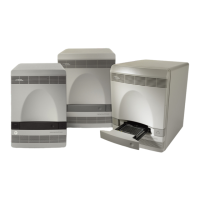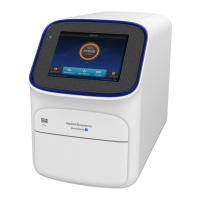DRAFT
September 25, 2007 1:07 am, 4376782_Glossary.fm
Glossary
143
Applied Biosystems StepOne
™
and StepOnePlus
™
Real-Time PCR Systems
Installation, Networking, and Maintenance Guide
CONFIDENTIAL — For AB Internal Use Only. Do Not Distribute.
nonfluorescent
quencher-minor
groove binder
(NFQ-MGB)
Molecules that are attached to the 3′ end of TaqMan
®
probes. When the probe is intact,
the nonfluorescent quencher (NFQ) prevents the reporter dye from emitting fluorescence
signal. Because the NFQ does not fluoresce, it produces lower background signals,
resulting in improved precision in quantitation. The minor groove binder (MGB)
increases the melting temperature (Tm) without increasing probe length. It also allows the
design of shorter probes.
normalized quantity Quantity of target divided by the quantity of endogenous control.
normalized reporter
(Rn)
Fluorescence signal from the reporter dye normalized to the fluorescence signal of the
passive reference.
omit well An action that you perform before reanalysis to omit one or more wells from analysis.
Because no algorithms are applied to omitted wells, omitted wells contain no results.
outlier For a set of data, a datapoint that is significantly smaller or larger than the others.
passive reference A dye that produces fluorescence signal. Because the passive reference signal should be
consistent across all wells, it is used to normalize the reporter dye signal to account for
non-PCR related fluorescence fluctuations caused by minor well-to-well differences in
concentrations or volume. Normalization to the passive reference signal allows for high
data precision.
plate layout An illustration of the grid of wells and assigned content in the reaction plate. In StepOne
™
systems, the grid contains 6 rows and 8 columns. In StepOnePlus
™
systems, the grid
contains 8 rows and 12 columns.
In the StepOne
™
software, you can use the plate layout as a selection tool to assign well
contents, to view well assignments, and to view results. The plate layout can be printed,
included in a report, exported, and saved as a slide for a presentation.
point One standard in a standard curve. The standard quantity for each point in the standard
curve is calculated based on the starting quantity and serial factor.
positive control In genotyping experiments, a DNA sample with a known genotype, homozygous or
heterozygous. In the StepOne
™
software, the task for the SNP assay in wells that contain
a sample with a known genotype.
post-PCR read Used in genotyping and presence/absence experiments, the part of the instrument run that
occurs after amplification. In genotyping experiments, fluorescence data collected during
the post-PCR read are displayed in the allelic discrimination plot and used to make allele
calls. In presence/absence experiments, fluorescence data collected during the post-PCR
read are displayed in the presence/absence plot and used to make detection calls. Also
called endpoint read.
pre-PCR read Used in genotyping and presence/absence experiments, the part of the instrument run that
occurs before amplification. The pre-PCR read is optional but recommended.
Fluorescence data collected during the pre-PCR read can be used to normalize
fluorescence data collected during the post-PCR read.
primer mix PCR reaction component that contains the forward primer and reverse primer designed to
amplify the target.
